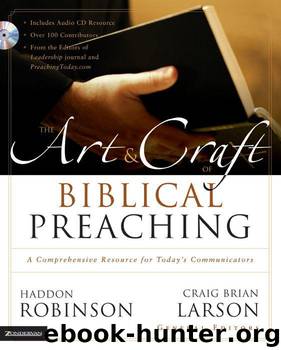The Art and Craft of Biblical Preaching: A Comprehensive Resource for Today's Communicators by Robinson Haddon & Larson Craig Brian

Author:Robinson, Haddon & Larson, Craig Brian [Robinson, Haddon]
Language: eng
Format: mobi
Tags: ebook, book
Publisher: Zondervan
Published: 2009-05-26T04:00:00+00:00
2. THE PREVIEW
In the preview paragraph of the introduction, you tell the listener, “Here’s where I’m going to go with this sermon.” In the preview you often make statements or raise the questions you’re going to answer. So right away you’re dealing with induction or deduction.
Any sentence is an idea. If I say, “This podium was made by a master craftsman,” that’s an idea. There is something I’m talking about (the podium), and there’s something I’m saying about it (it was made by a master crafts-man). It has a subject and a complement. When we make a deductive statement, we are giving the subject and the complement up front. When we raise a question, we are raising only the subject. So when we come to the preview sentences, we have to decide if we’re going to be deductive or inductive.
Let’s say I start my introduction by saying, “Early in geometry we learn that the shortest distance between two points is a straight line. Well, that may be true in geometry but not with God’s dealings in our life. Today we’re going to see that the shortest distance between two points is a zigzag. God will lead us in his own route to get us safely to his intended destination for us. Now, where do I find that in Scripture? We’re going to turn to a time in Israel’s history when God led them deliberately on a zigzag path.”
Now, that’s a deductive statement. I’ve given you what I’m going to talk about. But I’ve got some questions to answer about that. The listener is thinking, Is that true? Would God lead me on a zigzag path? I’ve been on my zag so long I don’t know whether point B is God’s destiny or I psyched myself into it. The movement of the text will follow that inductive development. I take them to Exodus 13, where it shows that God led Israel on a zigzag path. It tells them why he did that and how he kept them encouraged when they weren’t moving in a straight line.
I want the listener to say, “Oh, I’ve got to keep listening to that. You’re going to prove to me that God does do it.” That’s deductive. “Then you’re going to explain why. I need you to answer me that, and help me to know how I stay encouraged.” That’s inductive. So I’ve used a combination of deduction and induction in the preview elements to mark off the big chunks of the message while keeping the listener in a state of tension over unanswered questions.
Download
This site does not store any files on its server. We only index and link to content provided by other sites. Please contact the content providers to delete copyright contents if any and email us, we'll remove relevant links or contents immediately.
Victory over the Darkness by Neil T. Anderson(2733)
The Rape Of Nanking by Iris Chang(2653)
Chosen by God by R. C. Sproul(2057)
Crash the Chatterbox by Steven Furtick(1876)
Habits of Grace by David Mathis(1851)
Knowing God by J.I. Packer(1724)
How To Be Born Again by Billy Graham(1670)
Gospel-Shaped Marriage by Chad van Dixhoorn(1615)
A Prophet with Honor by William C. Martin(1603)
Peace with God by Billy Graham(1576)
Confronting Christianity by Rebecca McLaughlin(1498)
God's Smuggler by Brother Andrew(1441)
Angel Dreams by Virtue Doreen Virtue Melissa(1379)
Whisper by Mark Batterson(1346)
Missionaries by Norman Lewis(1342)
The Truth War by John MacArthur(1329)
The School of Biblical Evangelism by Ray Comfort(1327)
The Poems of Rowan Williams by Rowan Williams(1271)
Do Greater Things by Robby Dawkins(1243)
